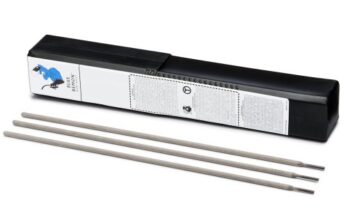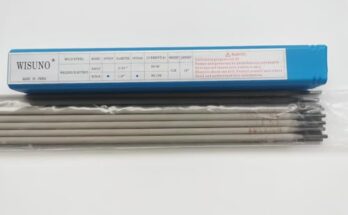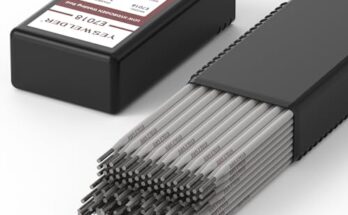Need to weld steel in a delicate situation or a low-heat environment? This guide dives into everything you need to know about low temp welding rods for steel, helping you choose the right tool for the job.
Let’s start with the basics. What exactly are low-temperature welding rods, and why are
they different from standard welding rods? Choosing the right welding rod is crucial for a successful weld, especially for thinner materials, delicate repairs, or when you’re working in an environment where excessive heat could damage surrounding components.
What Makes Low Temp Welding Rods Unique?
Unlike traditional welding rods that require high temperatures, low-temperature welding rods, also known as low-heat welding rods or cold welding rods, operate at significantly lower temperatures. This lower heat input minimizes the risk of warping, distortion, or damage to the base metal. They’re perfect for applications where precision and heat control are paramount. Think of repairing valuable antiques or delicate electronics – high heat would be disastrous! The reduced heat also reduces the amount of pre and post-weld clean up, which is especially important for work in tight spaces where access is difficult. This makes low temp welding rods incredibly versatile for a diverse range of applications. Many low-temp rods are designed to be used without any special equipment such as high-power inverters or specialized welding machines. In some cases, the addition of a simple heat source is enough to use them effectively.
Types of Low Temperature Welding Rods for Steel
There are several types of low-temperature welding rods available, each with its own properties and applications. Common types include those made from various alloys, specifically designed for steel. For instance, some contain flux to improve the weld’s flow and strength, while others are designed for specific types of steel – mild steel, stainless steel, and high-carbon steel all need different compositions. The exact composition of the rod impacts its tensile strength, heat resistance, and overall ease of use. It’s important to understand these properties before choosing the correct rod for your project. You wouldn’t use a rod meant for stainless steel on mild steel and expect a strong, lasting result; it simply won’t work effectively.
Choosing the Right Low Temp Welding Rod
Selecting the appropriate low-temp welding rod requires careful consideration of several factors. The wrong choice can lead to a weak weld, or damage to the surrounding metal, negating the whole point of using a low-temp rod in the first place.
Factors to Consider When Selecting a Rod
The selection of the correct welding rod depends on various factors. The most important is the type of steel being welded. Mild steel, high-carbon steel, stainless steel—each requires a rod formulated for its specific composition. The thickness of the steel is another critical factor. Thicker steel requires a rod capable of generating sufficient heat to penetrate deep enough for a robust weld. You need to consider the welding environment. Welding outdoors on a windy day necessitates a rod that will still perform effectively despite the environmental conditions. And, of course, the end goal and intended application of the weld will also determine your rod selection. A rod for repairing a delicate antique will be very different from a rod that you would use to join together components in an industrial setting. Choosing the right rod isn’t just a matter of convenience; it is crucial for the weld’s integrity and longevity.
Comparison of Different Low Temp Welding Rods
Let’s look at a few common types: Aluminum brazing rods are great for joining aluminum and its alloys, but not suitable for steel. There are specialized steel welding rods with lower melting points, which reduce heat input, making them ideal for low-temp welding. The key difference often lies in the composition of the alloy within the rod, the presence of a flux core (which promotes better flow), and the diameter of the rod itself, impacting how much heat is generated during the welding process.
| Rod Type | Steel Type | Thickness (Example) | Advantages | Disadvantages |
|---|---|---|---|---|
| Low-Temp Steel Rod (A) | Mild Steel | 1/8″ | Easy to use, minimal distortion | Lower strength compared to higher temp rods |
| Low-Temp Steel Rod (B) | Stainless Steel | 3/32″ | Corrosion resistant weld | Requires precise technique for optimal results |
| Low-Temp Steel Rod (C) | High-Carbon Steel | 1/16″ | High strength weld | More prone to cracking if not used correctly |
Applications of Low Temp Welding Rods for Steel
Low-temperature welding rods find applications in various industries and DIY projects.
Automotive Repair and Fabrication
Low-temp welding rods are frequently used in automotive repair, especially for delicate bodywork or exhaust system repairs. The lower heat significantly reduces the risk of warping or damaging surrounding parts. In this application, a smooth and precise weld is crucial for restoring the vehicle to its original condition and ensuring safety. Consider repairing a small hole in a car’s bumper or welding a broken exhaust pipe. Using high-heat welding techniques could easily warp the bumper, making the repair much more time consuming and less aesthetically pleasing. Low-temp welding ensures a minimally intrusive approach, reducing time and material costs.
Electronics and Precision Welding
The electronics industry benefits immensely from low-temp welding rods, as excessive heat can easily damage sensitive components. Consider a situation where a small wire needs to be reattached to a circuit board. High-heat welding could melt surrounding components and render the entire circuit board useless. Low-temp welding provides the precise control needed for this delicate task.
Safety Precautions When Using Low Temp Welding Rods
While low-temp welding is safer than traditional welding, certain precautions should always be taken.
Essential Safety Gear and Practices
Always wear appropriate safety gear, including welding goggles or a face shield to protect your eyes from sparks and UV radiation. Gloves are also crucial to protect your hands from heat and potential burns. Proper ventilation is necessary to avoid inhaling fumes produced during the welding process. It’s important to keep flammable materials away from the welding area and to have a fire extinguisher nearby. Even low-temp welding can produce enough heat to ignite certain materials, especially if not properly prepared. Using a low-temp welding rod doesn’t eliminate the need for safety; it merely reduces the risk.
Troubleshooting Common Issues
If you encounter problems like a weak weld, it’s essential to troubleshoot the root cause. This could stem from incorrect rod selection for the base metal, insufficient heat input, improper cleaning of the base metal before welding, or a lack of proper technique. It’s always advisable to consult the instructions and specifications provided by the manufacturer for the specific welding rod being used. Learning about appropriate clamping techniques and preparation steps is also key to successful low temp welding.
Comparing Low Temp Welding to Other Welding Techniques
Let’s compare low-temp welding with other methods.
Low Temp Welding vs. Arc Welding
Arc welding generates far higher temperatures than low-temp welding, making it unsuitable for delicate work or thin materials. Arc welding is often used for heavier materials where strength and robustness are paramount, but it results in greater heat distortion. Low-temp welding is a superior choice when precision and minimal heat distortion are critical.
Low Temp Welding vs. MIG Welding
MIG welding (Metal Inert Gas) is another popular technique, offering good speed and efficiency. However, MIG welding also generates higher temperatures than low-temp welding. While MIG welding might be faster, low-temp welding is preferred when working with delicate components where minimal heat is paramount. MIG welding can be used for steel, but the heat can be challenging to manage in some applications. Low-temp welding offers the necessary level of control for such precision work.
Advanced Techniques and Considerations
As you gain experience, you can explore advanced techniques.
Flux-Cored vs. Solid Core Rods
Flux-cored rods contain a flux material that improves the flow of the weld and protects it from oxidation. Solid core rods don’t have flux, and often require a more skilled welder who can control the weld puddle effectively. The choice between flux-cored and solid core low-temp rods depends on your experience level and the specific requirements of the project. Flux-cored rods are generally easier to use for beginners, resulting in a more consistent weld.
Choosing the Right Flux for Optimal Results
Different fluxes are available for various types of steel and welding applications. Selecting the proper flux ensures a smooth and robust weld. Each flux is specifically formulated to improve the flow and penetration of the welding rod within the base material. The use of the correct flux is critical for preventing defects and ensuring that the weld is smooth, strong, and consistent. Improper flux choices can lead to porosity, weakness, or lack of weld penetration, resulting in a flawed weld.
The Future of Low Temp Welding Rods for Steel
The demand for precision welding continues to grow across various industries.
Technological Advancements and New Alloys
Ongoing research and development are leading to new alloys and formulations of low-temp welding rods, continuously improving their strength, ease of use, and overall performance. The development of new materials is focusing on greater strength and improved versatility, broadening the applications where low-temp welding can be successfully employed. As technology advances, we can expect even more innovative solutions that meet the growing need for advanced welding techniques.
Applications in Emerging Technologies
With the rise of industries like robotics and micro-electronics, low-temp welding is taking center stage. The ability to weld delicate components without causing damage is critical for the successful production and maintenance of these sensitive systems. The future of low-temp welding looks bright, and its applications are only expected to increase.
Frequently Asked Questions
What is low temp welding rods for steel best for?
Low-temp welding rods for steel are best suited for applications where minimal heat input is crucial, such as repairing delicate components, electronics, or thin-gauge steel without causing warping or damage. They are ideal for situations where precision and control are paramount. The low heat reduces the risk of distortion to the surrounding metal which is particularly important when working with older metal parts or materials that are susceptible to damage from intense heat. Learn more about the different types of steel and the ideal rods to use with them.
What are the advantages of using low-temp welding rods?
The primary advantages include reduced heat distortion, increased precision, and suitability for delicate materials. They minimize the risk of warping or damage to surrounding components, making them perfect for repairing valuable items or working on sensitive electronics. The low heat also translates into reduced pre and post welding cleanup. Learn more about the specific advantages of low temp welding rods compared to other methods.
What safety precautions should I take when using low-temp welding rods?
Always wear appropriate safety gear, including welding goggles or a face shield, gloves, and ensure adequate ventilation. Keep flammable materials away from the welding area and have a fire extinguisher nearby. Even though the heat generated is lower compared to other methods, safety precautions are still crucial. Consult the manufacturer’s instructions for specific safety guidelines concerning the chosen welding rod.
Can I use low-temp welding rods on all types of steel?
No, different low-temp welding rods are formulated for different types of steel (mild steel, stainless steel, high-carbon steel, etc.). Using the wrong rod can result in a weak or brittle weld. Choosing the correct rod is crucial for a successful weld, ensuring proper strength and preventing flaws. It is important to carefully consider the type of steel before selecting a welding rod.
How do I prepare the steel before welding with low-temp rods?
Proper surface preparation is key to a successful weld. Clean the steel surface thoroughly, removing any rust, dirt, grease, or paint. This ensures a strong bond between the rod and the steel. The cleanliness of the metal surface impacts the success of the weld; without appropriate preparation, the weld may be weak or prone to failure. Learn more about surface preparation techniques for optimal welding results.
What are the limitations of low-temp welding rods?
While low-temp welding rods offer many advantages, they might not be suitable for all applications. They may not achieve the same high strength as high-temperature welding methods, and they are generally less efficient for welding thick steel. They are best suited for situations where precision and minimal heat input are paramount.
Where can I buy low-temp welding rods?
Low-temp welding rods are readily available at most welding supply stores, both online and in physical locations. You can also find them at some hardware stores. Be sure to check product reviews and compare different brands before making a purchase to ensure that you are getting high-quality welding rods. When selecting a vendor, make sure that they have good customer service in case there are any issues with your order.
Final Thoughts
Low-temp welding rods for steel offer a valuable solution for a wide range of applications where precision and minimal heat distortion are crucial. By understanding the different types, selecting the right rod for your project, and practicing safe welding techniques, you can achieve strong and reliable welds even in delicate situations. From repairing valuable antiques to working on sensitive electronic components, the versatility and control offered by low-temp welding make it an indispensable tool for many professionals and DIY enthusiasts alike. So, choose wisely, weld safely, and explore the possibilities that low-temp welding offers!


